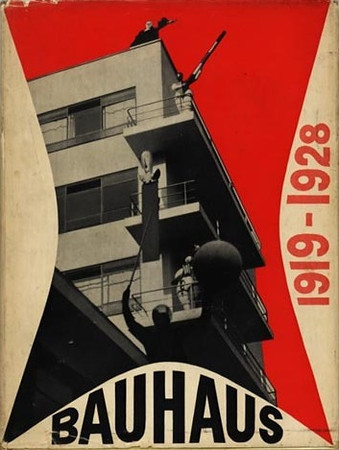Herbert Bayer, Walter Gropius, Ise Gropius (eds.): Bauhaus 1919–1928 (1938)
Filed under book, catalogue | Tags: · 1920s, architecture, art, art history, avant-garde, bauhaus, design, graphic design, industrial design, painting, photography, sculpture, typography


Bauhaus 1919-1928 remains one of the most valuable accounts of the Bauhaus school. The book was published in conjunction with the Museum Of Modern Art exhibition (December 7, 1938-January 30, 1939) and is a point-for-point record of actual programs and projects at the Bauhaus, prepared by Herbert Bayer under the general editorship of Walter Gropius and Ise Gropius and with the collaboration of a dozen other Bauhaus teachers — including Kandinsky, Klee, Feininger, Schlemmer, Itten, Moholy-Nagy, Albers, and Breuer. Rather than a retrospective history, it is a collection of photographs, articles, and notes prepared on the field of action. It may be considered as much a work of the Bauhaus as it is a work about it.
Includes work by all the Bauhaus faculty including Walter Gropius, Paul Klee, Wassily Kandinsky, Laszlo Moholy-Nagy, Marcel Breuer, Herbert Bayer, Josef Albers, Lyonel Feininger, Oskar Schlemmer, Hannes Meyer, Mies van der Rohe, Anni Albers, Otti Berger, Gunta Stolzl, Max Bill and many others.
The exhibition gave the first comprehensive review of the development of the institute under Gropius (no material from the later Bauhaus was shown). Preparation and technical arrangements were entrusted to Herbert Bayer, paving the way for his own emigration to America shortly afterwards. An accompanying Bulletin was a privilege, sent to members of MOMA. (Source)
Bauhaus 1919-1928
With a Preface by Alfred H. Barr, Jr.
Publisher Museum of Modern Art, New York, 1938
224 pages
via Joaquim Moreno, update via MoMA
The Bulletin of the Museum of Modern Art 6, Vol. 5 (Dec 1938): Bauhaus Exhibition
Publisher Museum of Modern Art, New York, 1938
8 pages
via David Levine
PDF (Book, 42 MB, updated on 2016-9-17)
PDF (Bulletin)
Dawn Ades, Simon Baker (eds.): Undercover Surrealism: Georges Bataille and DOCUMENTS (2006)
Filed under book, catalogue | Tags: · 1920s, 1930s, archaeology, art, art history, avant-garde, ethnography, film, painting, photography, sculpture, surrealism

“In the Paris art world of the 1920s, Georges Bataille and his journal DOCUMENTS represented a dissident branch of surrealism. Bataille—poet, philosopher, writer, and self-styled “enemy within” surrealism—used DOCUMENTS to put art into violent confrontation with popular culture, ethnography, film, and archaeology. Undercover Surrealism, taking the visual richness of DOCUMENTS as its starting point, recovers the explosive and vital intellectual context of works by Picasso, Dalí, Miró, Giacometti, and others in 1920s Paris. Featuring 180 color images and translations of original texts from DOCUMENTS accompanied by essays and shorter descriptive texts, Undercover Surrealism recreates and recontextualizes Bataille’s still unsettling approach to culture. Putting Picasso’s Three Dancers back into its original context of sex, sacrifice, and violence, for example, then juxtaposing it with images of gang wars, tribal masks, voodoo ritual, Hollywood musicals, and jazz, makes the urgency and excitement of Bataille’s radical ideas startlingly vivid to a twenty-first-century reader.”
With contributions by Fiona Bradley, Neil Cox, Caroline Hancock, Denis Hollier, William Jeffett, CFB Miller, Michael Richardson, and Ian Walker.
Publisher Hayward Gallery, London, with MIT Press, Cambridge/MA, 2006
ISBN 1853322504, 9781853322501
272 pages
Exh. reviews: Peter Suchin (Frieze), Benjamin Noys (Radical Philosophy), John Phillips and Ma Shaoling (Theory, Culture & Society).
Wikipedia
PDF (104 MB, updated on 2020-2-20)
Comments (6)László Moholy-Nagy: The Art of Light (2010) [Spanish]
Filed under book, catalogue | Tags: · art, avant-garde, bauhaus, constructivism, film, graphic design, light art, painting, photography, sculpture, typography

An artist and thinker of astounding energy and ability, Laszlo Moholy-Nagy was a true world citizen of the early twentieth century, an ambassador-at-large for Constructivism, Suprematism, Dada and the Bauhaus. He brought the same Constructivist optimism to every medium he tackled, from plexiglass and light sculpture to typography to his photographic experiments in color to his Suprematist canvases, his influential pedagogy at the Bauhaus and at the Institute of Design in Chicago. Moholy-Nagy’s concept of the arts as a totality, his pedagogy and his confidence in the new industrial culture that would level distinctions between art and craft led him into all fields of creative production. The ultimate modernist Renaissance man, Moholy-Nagy was prolific in so many realms that his detractors inevitably charged him with dilettantism. This accusation ignores his very real innovations in photography–for example his photograms–and light sculpture, as well as the fact that the artist’s aims possessed a conceptual unity in their common aspiration to make an “art of light.”
László Moholy-Nagy: The Art of Light presents Moholy-Nagy’s work in all of its glorious unity and diversity. Including more than 200 works, from painting, photography (black and white and color) and photograms to collages, films and graphic design, it emphasizes his greatest years of productivity, from 1922 to the end of his life. The Art of Light is the new definitive volume on this hero of modernism.
László Moholy-Nagy: El Arte de la Luz
Book coordination: Doménico Chiappe, Luisa Lucuix
Editor: Emilio Ruiz Mateo
Publisher: La Fábrica Editorial / Círculo de Bellas Artes, Madrid
ISBN: 8492841257, 9788492841424
264 pages
exhibition (Madrid, 2010)
Comment (0)
